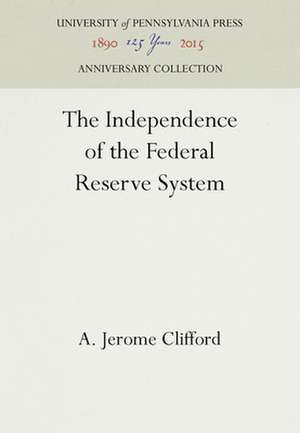The Independence of the Federal Reserve System
Autor A. Jerome Clifforden Limba Engleză Hardback – 28 iul 1965
The powers and responsibilities given to the new system were enveloped in structural arrangements designed to assure the organization itself as well as the nation that there would be competent, adequate, and independent authority to provide for a more efficient monetary system. Although unique, the solution was not simple in either structure or operation, for besides protecting itself from the dangers of government or private banker domination, the Federal Reserve System had to win and keep the help and cooperation of this same government and these same private banks.
The System maintained its independence in two ways. First, the Federal Reserve System found its fundamental meaning in the governmental function delegated to it by Congress--the formation and execution of credit and monetary policy for public purposes. Yet it was set apart from the ordinary legislative and executive departments of the government. Second, the System worked to achieve its purposes by acting through and with the cooperation of the nation's private financial interests. Yet it was separate from those interests. The Federal Reserve System was designed to cooperate and still be independent. How it promoted this harmony, and yet avoided domination was its glory and its cross. It is of the history of this achievement that this book tells.
Preț: 675.92 lei
Preț vechi: 759.45 lei
-11% Nou
129.38€ • 140.58$ • 108.75£
Carte tipărită la comandă
Livrare economică 21 aprilie-05 mai
Specificații
ISBN-10: 0812273885
Pagini: 436
Dimensiuni: 140 x 210 x 15 mm
Greutate: 0.78 kg
Ediția:Reprint 2016
Editura: MT – University of Pennsylvania Press
Cuprins
The Issue of Independence
The Necessity for Independence
The Weakness of the Structural Arrangement
The Operational Problems of Independence—1914-1930
Federal Reserve Relations with the Government in the Thirties
Federal Reserve Relations with the Government During World War II
Federal Reserve Relations with the Government in the Early Postwar Period
The Renascence of the Independence Issue—The 1951 Accord
The Consolidation of Independence After the Accord
Treasury-Federal Reserve Relations After the Accord—Theory And Practice
The Congressional Case for Control of the Federal Reserve System
The Congressional Means for Control of the Federal Reserve System
The Ownership of Federal Reserve Bank Stock as an Issue of Independence
The Independence of the Federal Reserve System—Retrospect And Prospect
Bibliography
Index
